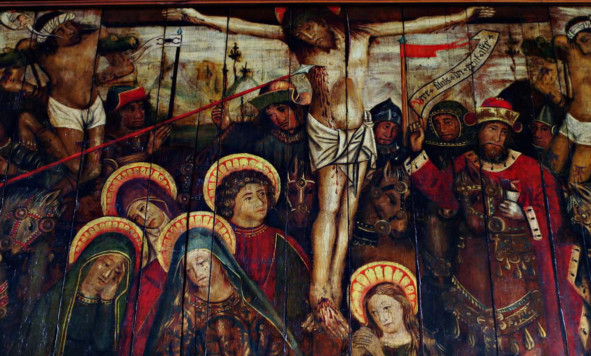A new BBC documentary shines light on an exuberant medieval painting of the Crucifixion which survived Scotland’s Protestant Reformation in an Angus church.
There has been a house of prayer on the site of St Marnock’s Church, Fowlis Easter, north of Dundee, for more than eight centuries, with the church as it now stands built in 1453.
But it was the events of 1612 when the Synod of Fife ordered the destruction of Catholic art at the church which will feature in a BBC documentary tonight.
During the 16th century the Protestant Reformation in Europe almost entirely rejected the existing tradition of Catholic art, and very often destroyed as much of it as it could reach.
And yet in the tiny church of Fowlis Easter, an exuberant painting of the Crucifixion dating from the late 1400s, survived.
In an interview with The Courier, the minister of Fowlis and Liff linked with Lundie and Muirhead, Rev Donna Hays, told how the relatively rural location of the church, and the thrawn nature of the 16th century congregation, may have led to the painting being saved.
She said: “The painting is unique because there is no other pre-Reformation painting of the Crucifixion in existence which has a fool, or jester, in it. He was put in the painting standing grinning out at people. It comes from one of the psalms which says the fool doesn’t recognise God. What the fool is doing in this painting is saying ‘I don’t see God on the cross, are you a fool like me?’. That’s what is significant, because the anonymous artist, thought to be from the Netherlands, is not one of the top-rated ones.”
The painting is thought to date from the early days of the current church which was built by the 1st Lord Gray in 1453. He would have commissioned an artist and is himself featured in the painting. It was originally part of the Rood screen which separated the congregation from the priests, and ran the whole width of the church.
With much of the medieval congregation unable to read, its purpose was to tell the story of the Crucifixion in pictures.
But when the St Andrews-based Synod of Fife, which had control over the church, ordered that items of religious idolatry from the Catholic era be destroyed, it seems that the painting initially survived.
Rev Hays added: “The orders were for such paintings to be burned, chopped or whitewashed over to destroy or hide idolatry. It seems the Synod came to Fowlis three times, but because the church was quite remote and transport difficult in those days, it would have been more difficult to check if the destruction had actually taken place.
“The painting was apparently undamaged until 1612 when it was whitewashed over.”
Rev Hays said carvings of saints in the church were also struck off but one must have been kept as it was later stuck back on.
Today she said there was a lot of interest from St Andrews University art history students in the painting and research trips would regularly be made.
The cleaned-up painting is now on the wall of the church on wooden panels.
Rev Hays, 63, a former school teacher who has been minister at Fowlis for 11 years, added: “Our rural congregation has a great respect for history and we are thriving in the modern day.”
The story of Scottish art and its impact on the international art world is celebrated in the new four-part series by BBC Scotland. The opening programme includes a segment on the Fowlis painting.
Presented by acclaimed artist Lachlan Goudie, the series covers 5000 years, from the earliest Neolithic art to the present day.
Seen through the eyes of an artist, The Story of Scottish Art explores developments and innovations in art across the centuries, placing Scottish art in an international context, and at the same time telling a compelling story about Scotland’s social and political history.
Mr Goudie said: “Scotland’s artistic heritage is rich and complex.
“As a painter myself I feel a real urge to understand the motivations and the challenges that have confronted artists from Scotland throughout the centuries. How they’ve helped define their own culture whilst being informed and inspired by the most revolutionary international art movements of the day.”
In episode one, the story begins in the mysterious Kilmartin Glen, in Argyll, where rocks are marked with strange cup and ring patterns.
His journey into the world of Neolithic art then takes him to Orkney, to the Ring of Brodgar, where he learns that the walls of houses were adorned with vibrant colours, and on the island of Westray he meets an ancient figurine the Westray Wife the oldest sculpted human figure in the British Isles. He revels in the beautifully illuminated pages of the Book of Kells, and finds that it was not only the Christian Gaels who were forging sophisticated art but also the contemporary Picts.
* The Story of Scottish Art airs on Wednesday October 7, BBC Two Scotland, 9pm to 10pm.
